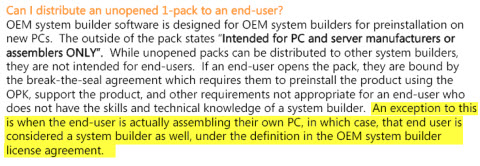OEM licensing confusion starts at Microsoft.com

Last week, in the wrap-up for a post about WGA, I offered five suggestions I’d like to see incorporated into Vista and especially into Windows 7. Number 1 on the list was a request to make Windows licensing and activation simpler. I noted:
It is almost impossible for mere mortals to understand the nuances of OEM SLP activation and why the product key on the sticker on the side of your PC won’t work after you reinstall Windows. Corporations can pay people to figure this stuff out. Consumers and small business people shouldn’t have to.
Today, as I was poking around Microsoft’s OEM Partner Center (restricted to enrolled members only), I found a perfect example of how much confusion surrounds the subject of licensing. Can an end user purchase an OEM System Builder copy of Windows and use it to build his/her own PC? Absolutely yes! Definitely not! Seriously, two pages on this supposedly authoritative information source for OEMs contain information that is completely contradictory. No wonder mere mortals get confused by this stuff.
Back in August 2005, Microsoft made some substantial changes to its license for OEM System Builder copies of Windows. Previously, the terms for these Windows versions were simply ridiculous. You could buy an OEM copy of Windows from a reseller such as Newegg or Mwave, but only if you purchased a “qualifying non-peripheral computer hardware component” with it. As a result, resellers had to go through the charade of bundling a 99-cent power cable to make the purchase legal, and then they had to keep a record of the bundled purchase in case Microsoft did an audit of their sales.
As I noted back then, the new license terms were considerably saner. Microsoft introduced a single-pack edition of its OEM System Builder software and allowed resellers to distribute unopened packages to another “system builder” without requiring a trivial hardware purchase. In the documentation announcing the change in license terms, Microsoft specifically noted that end users could take advantage of this option as well, as long as they were building a system for their own use. The following language was included in a web page at the OEM Partner Center and in a PDF handout made available for OEM partners:
OEM system builder software packs are intended for PC and server manufacturers or assemblers ONLY. They are not intended for distribution to end users. Unless the end user is actually assembling his/her own PC, in which case, that end user is considered a system builder as well.[emphasis added]
In late 2006, I downloaded that PDF file, bookmarked that web page, and took a snapshot of the page as well, thinking it might come in handy some day. I’ve referred to that language repeatedly when writing about OEM licenses over the past few years, and I’ve checked those pages as recently as December 2007.
I can no longer find the PDF document on Microsoft’s website, but I still have a copy saved locally. Here’s a picture of the relevant portion (I've used a yellow highlighter to mark the relevant portions of each graphic in this post):
Fortunately, the page I quoted from more than three years ago, Simplified OEM Licensing, is still available, with a 2008 copyright date attached to it. It begins with this unintentionally ironic text:
Software licensing is not an easy subject to understand. Some of our previous requirements raised questions such as, "What is non-peripheral hardware?" "Why are the distribution and preinstallation requirements different for Windows and Office?" and "What can and can’t I do with OEM system builder software and hardware?"
That is why Microsoft has simplified the OEM system builder license for you.
At the bottom of that page is a three-part section entitled “Scenarios,” which ends with a graphic and caption containing the text shown below. This text has been there since August 2005:
Sounds pretty cut and dried, until you scour the Microsoft site for additional details. This page, Windows Licensing for Do-It-Yourself PC Hobbyists, does not appear to be linked from anywhere else on the OEM Partner Center. I found it only by running a custom search within the OEM Partner Center using the keyword hobbyists. (The page is also not in the Windows Live Search index, and a Google search turns up links to it from only a handful of external pages, mostly translations on foreign-language sites at Microsoft.com.) Here’s how the page begins:
There is a growing market for “do-it-yourself” home PC hobbyists who assemble PCs from components for their own use. Microsoft retail software licenses are the appropriate licenses for the do-it-yourself market. OEM System Builder software is not intended for this use, unless the PC that is assembled is being resold to another party. Please see further clarification below. [emphasis added]
And here’s a snapshot of the top of the page:
Like I said, it’s almost impossible for mere mortals to understand the nuances of this stuff. Even when they work at Microsoft.
